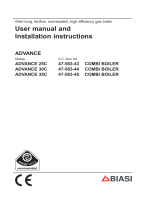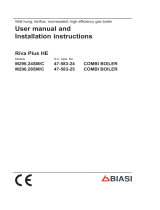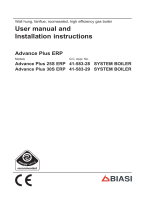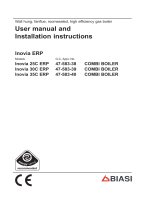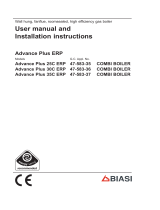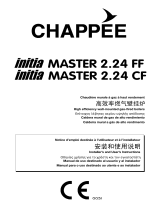Page is loading ...

Wall hung, fanflue, roomsealed, high efficiency gas boiler
User manual and
Installation instructions
Inovia
Models G.C. Appl. No.
Inovia 25C 47-583-32
Inovia 30C 47-583-33
Inovia 35C 47-583-34

- 2 -
WARNING
Congratulations on your choice.
Inovia are condensing high efciency sealed chamber fan ue gas boilers. They are fully
electronically controlled and have electronic ignition.
The materials they are made of and the control systems they are equipped with give you
safety, a high level of comfort and energy savings to allow you to get the greatest benet out
of independent heating.
Inovia allow a higher efciency by reducing the ue gas temperature such that the water
vapour formed during the combustion is condensed out.
This allows a gain of useful heat that otherwise would be lost.
Biasi UK Ltd is a licensed member of the Benchmark Scheme which aims to improve the
standards of installation and commissioning of domestic heating and hot water systems in
the UK and to encourage regular servicing to optimise safety, efciency and performance.
Benchmark is managed and promoted by the Heating and Hot water Industry Council. For
more information visit www.centralheating.co.uk.
DANGER: The indications marked with this symbol must be observed to pre-
vent accidents of mechanical or generic origin (e.g.: Injuries or bruises).
DANGER: The indications marked with this symbol must be observed to pre-
vent accidents of electric origin (electrocution).
DANGER: The indications marked with this symbol must be observed to pre-
vent the risk of re or explosion.
DANGER: The indications marked with this symbol must be observed to pre-
vent accidents of heat origin (burns).
ATTENTION: The indications marked with this symbol must be observed to
prevent malfunctioning and/or damage to materials of the appliance or other
objects.
ATTENTION: The indications marked with this symbol is important informa-
tion that must be carefully read.

- 3 -
WARNING
Remember that...
The manual must be read thoroughly, so that you will be able to use the boiler in a safe
and sensible way; must be carefully kept. It may be necessary for reference in the future.
The lighting up must be carried out by competent and responsible engineer.
The manufacturer
• disclaim all liability for any translations of the present manual from which incorrect inter-
pretation may occur;
• cannot be held responsible for non-observance of instructions contained in this manual
or for the consequences of any procedure not specically described.
Guarantee conditions
• The guarantee registration form must be returned within 30 of purchase, failure to com-
ply will invalidate the guarantee.
Please ensure that the installer has fully completed the Benchmark Checklist on the inside
back pages of the installation instructions supplied with the product and that you have signed
it to say that you have received a full and clear explanation of its operation. The installer is
legally required to complete a commissioning checklist as a means of complying with the ap-
propriate Building Regulations (England and Wales).
All installations must be notied to Local Area Building Control either directly or through a
Competent Persons Scheme. A Building Regulations Compliance Certicate will then be is-
sued to the customer who should, on receipt, write the Notication Number on the Benchmark
Checklist.
This product should be serviced regularly to optimise its safety, efciency and performance.
The service engineer should complete the relevant Service Record on the Benchmark Check-
list after each service.
The Benchmark Checklist will be required in the event of any warranty.
Using the boiler...
Before lighting the boiler you are advised to have a Gas Safety Registered Engineer
check that the installation of the gas supply
• is gas-tight;
• is of the correct gauge for the ow to the boiler;
• is tted with all the safety and control devices required by the current Regulations.
Ensure that
• Check with the Installer that he has connected and terminated the pressure relief valve in
a manner which allows safe discharge. The manufacturers are not responsible for dam-
age caused by opening of the pressure relief valve and consequent escape of water, if
this is not connected and terminated.
• The installer has connected the condensate outlet to a suitable drain pipe.

- 4 -
WARNING
On detecting the smell of gas:
• don’t operate any electrical switches, the telephone or any device that may produce
sparks;
• open the windows and doors at once to create a draught of air which will purge the area;
• shut off the gas cocks;
• get the assistance of a qualied person. Emergency telephone number
Tel 0800 111999.
Do not touch the appliance with parts of the body that are wet or damp and/or bare feet.
Do not block or modify the condensate outlet and pipework.
In case of structural work or maintenance near the exhaust duct and/or fume exhaust
devices or their attachments, turn off the appliance. On completion of the work, have a
professionally qualied person check their efciency.
Repairs (under guarantee) must be carried out only by a Biasi approved engineer, using
genuine spare parts. Thus do no more than switching off the boiler yourself (see the in-
structions).
Your boiler allows heating up of water to a temperature less than boiling point;
• must be connected to a central heating system and/or a hot water supply system, com-
patible with its performance and output;
• can be used only for those purposes for which it has been specially designed;
• must not be touched by children or by those unfamiliar with its operation;
• must not be exposed to weather conditions.
During the operation it is quite normal that the boiler produces a white plume of conden-
sation vapour from the ue terminal. This is due to the high efciency of the appliance and
may be particularly evident with low outdoor temperatures.
Safe handling of substances
Biasi products are manufactured in accordance with ISO 9001 and do not, and will not, con-
tain any hazardous materials or substances such as asbestos, mercury or C.F.C.’s. The ap-
pliance packaging does not contain any substances, which may be considered a hazard to
health.
When handling or lifting always use safe techniques
• Keep your back straight, bend your knees, don't twist.
• Move your feet, avoid bending forwards and sideways and sand keep the load as close to
your body as possible.
Where possible transport the boiler using a sack truck or other suitable trolly.
Always grip the boiler rmly, and before lifting feel where the weight is concentrated to estab-
lish the centre of gravity, repositioning yourself as necessary.

- 5 -
WARNING
Combustion chamber panels
Material: mineral bres
Known hazards - Some people can suffer reddening and itching of the skin. Fibre entry into
the eye will cause foreign body irritation, which can cause severe irritation to people wearing
contact lenses. Irritation to respiratory tract.
Precautions - Dust goggles will protect eyes. People with a history of skin complaints may
be particularly susceptible to irritation. High dust levels are only likely to arise following harsh
abrasion. In general, normal handling and use will not present high risk, follow good hygiene
practices, wash hands before, touching eyes, consuming food, drinking or using the toilet.
First aid - Medical attention must be sought following eye contact or prolonged reddening of
the skin.
Thermostat / Temperature gauge
Description - Sealed phial and capillary containing liquid.
Known hazards - irritating to skin, eyes and throat. Vapour is harmful. Inammable -do not
extinguish with water.
Precautions - Do not incinerate. Avoid contact with broken/leaking phials. Do not purposely
puncture.
First aid - medical attention must be sought following eyes/skin contact, wash with clean
water.
Sharp Edges
Caution should be taken when handling the boiler to avoid sharp edges on the boiler.
Boiler installation and commissioning tips
The installation must be carried out by a qualied Gas Safety Registered Engineer who
will be responsible for observing the current Regulations and the completion of the Bench-
mark Gas Boiler System Commissioning Checklist, located at the back of this User manu-
al.
Installing the boiler...
Do not forget to remove the transit caps and plugs from the boiler connections these are
tted to every boiler.
Keep the boiler clear of dust during installation and in particular do not allow any dust or
debris to enter the top of the boiler where the ue connection is made. It is recommended
that you put a dust sheet over the top of the boiler until you are ready to make the ue
connection.
Because every boiler is red and tested live at the factory, a small amount of water re-

- 6 -
WARNING
Appliance category: II2H3P (gas G20 20 mbar, G31 37 mbar)
Country of destination: United Kingdom (GB) Ireland (IE)
This appliance conforms with the following EEC directive:
Gas Directive 2009/142/CE
Boiler Efciency Directive 92/42/CEE
Electromagnetic Compatibility Directive 2004/108/CE
Low Voltage Directive 2006/95/CE
The manufacturer, in the continuous process to improve his products, reserves the right to modify the data expressed
in the present documentation at any time and without prior notice.
The present documentation is an informative support and it can not be considered as a contract to-wards third parties.
mains within the boiler. It is possible for this water to initially cause the pump to seize. It is
therefore recommended that the pump rotor be manually turned to free its rotation before
turning the boiler on.
Remember to release the auto air purge before lling the boiler. See the instructions to
identify the location of this device.
This boiler allows to control the ow temperature of the central heating system at very low
levels. In case of underoor heating system a temperature limiting device (e.g. a safety
thermostat) is recommended to stop the boiler in case that the water temperature exceeds
the design temperature.
You are strongly advised to ush out the system both cold and hot to the British Standard
BS 7593-2006 Code of practice, in order to remove system and installation debris.
It is also sensible to initially re and commission the boiler before connecting any external
controls such as a room thermostat. By following this procedure, if you have a subsequent
problem following the addition of an external control, you can eliminate the boiler from your
fault analysis.
If the boiler is tted with a digital programmer, when setting the times for automatic opera-
tion, remember that for every “ON” time there must be an “OFF” time to follow and that on
every occasion you enter a time you must also indicate which days that you want the boiler
to follow the timed settings.
Some products incorporate an anti cycling time delay. It is normal when rst switching the
boiler on for the boiler to operate on heating for a few seconds then switch off. After 3 - 4
minutes has elapsed the boiler will then re ignite and operate perfectly normally. The igni-
tion delay cycle does not prevent normal operation of the boiler to provide d.h.w.
If you are in any doubts as to the installation or operation of the boiler please read the
instruction manuals thoroughly and then if necessary contact Biasi UK for advice and as-
sistance.
Please remember that if you are in any doubt about the installation of this product you can
contact our Technical Help line on tel. 01922 714 600.
Abbreviations used in the manual:
C.h. = Central heating
D.h.w. = Domestic hot water
D.c.w. = Domestic cold wate

- 7 -
TABLE OF CONTENTS
1 APPLIANCE DESCRIPTION ............ 8
1.1 Overview ............................... 8
1.2 Isolation valves........................... 8
1.3 Controls panel ........................... 9
1.4 LCD general features ..................... 10
2 INSTRUCTIONS FOR USE . . . . . . . . . . . . 14
2.1 Warnings .............................. 14
2.2 Relling procedure ....................... 14
2.3 Ignition ................................ 15
2.4 C.h. circuit temperature ................... 16
2.5 D.h.w. temperature ....................... 21
2.6 3 star preheating function.................. 21
2.7 Extinguishing ........................... 23
3 USEFUL ADVICE.................... 24
3.1 Central Heating ......................... 24
3.2 Frost protection ......................... 24
3.3 Condensate drain ........................ 24
3.4 Periodic maintenance..................... 24
3.5 External cleaning ........................ 25
3.6 Operational faults ........................ 25
3.7 Displaying in INFO mode .................. 26
3.8 Remote anomaly code .................... 28
3.9 Flue probe ............................. 28
4 TECHNICAL INFORMATION........... 29
4.1 Overview .............................. 29
4.2 Main diagram ........................... 30
4.3 Technical data Inovia 25C ................. 32
4.4 Technical data Inovia 30C ................. 35
4.5 Technical data Inovia 35C ................. 38
4.6 Hydraulic specications ................... 41
4.7 Expansion vessel ........................ 41
5 GENERAL REQUIREMENTS .......... 42
5.1 Related documents ...................... 42
5.2 Location of appliance ..................... 42
5.3 Flue system ............................ 43
5.4 Gas supply ............................. 44
5.5 Air supply .............................. 44
5.6 Ventilation.............................. 44
5.7 Condensate drain ........................ 44
5.8 Water circulation (c.h.) .................... 45
5.9 Domestic water.......................... 46
5.10 Water treatment ......................... 47
5.11 Electrical supply ......................... 47
6 INSTALLATION ..................... 48
6.1 Warnings .............................. 48
6.2 Precautions for installation ................. 48
6.3 Installing the bracket ..................... 49
6.4 Overall dimensions....................... 50
6.5 Joints ................................. 50
6.6 Mounting the boiler....................... 50
6.7 Fitting the ue system .................... 51
6.8 Choice of u ............................ 52
6.9 Electric connection ....................... 55
6.10 Connecting the room thermostat or zone valves 57
6.11 External frost protection ................... 59
6.12 Installation of the external temperature probe
(optional) .............................. 60
6.13 Electric connection between the boiler and the
external probe .......................... 60
6.14 Remote electric connection (optional) ........ 60
6.15 Example of hydraulic plants with hydraulic
separator .............................. 61
7 COMMISSIONING . . . . . . . . . . . . . . . . . . . 62
7.1 Warnings .............................. 62
7.2 Electrical installation...................... 62
7.3 Gas supply installation .................... 62
7.4 Filling the d.h.w. system ................... 62
7.5 Initial lling of the system .................. 62
7.6 Condensate pipe and traps ................ 63
7.7 Checking the gas supply pressure ........... 64
7.8 Checking the inlet pressure ................ 64
7.9 Lighting the boiler ........................ 65
7.10 Enabling functioning of the external
temperature probe by the remote control ...... 66
7.11 Setting the K coefcient of the external
temperature probe ....................... 67
7.12 Setting the pump speed ................... 69
7.13 Setting the pump post-circulation ............ 70
7.14 Selecting the reignition frequency ........... 72
7.15 Checking the ignition device................ 73
7.16 Checking the ue system .................. 74
7.17 Checking the condensate drain pipe ......... 74
7.18 Instructing the user....................... 74
7.19 Adjustment of useful c.h. output ............. 74
7.20 Setting record ........................... 75
8 GAS CONVERSION ................. 77
8.1 Warnings .............................. 77
8.2 Operations and gas setting ................ 77
9 MAINTENANCE..................... 79
9.1 Warnings .............................. 79
9.2 Programming the maintenance period ........ 79
9.3 Dismantling the external panels ............. 80
9.4 Reassembly the external panels ............ 81
9.5 Emptying the d.h.w. system ................ 81
9.6 Emptying the c.h. system .................. 82
9.7 Cleaning the condensing primary exchanger
and the burner .......................... 82
9.8 Check the pressure of the heating expansion
vessel ................................. 83
9.9 Cleaning the domestic hot water exchanger ... 83
9.10 Checking the ue expulsion pipe ............ 84
9.11 Combustion analysis check ................ 84
9.12 Checking the condensate drain pipe ......... 85
9.13 Visual inspection of appliance .............. 85
9.14 Checking the gas supply pressure ........... 85
9.15 Water inhibitor concentration ............... 85
9.16 Setting the boiler chimney sweep function ..... 85
Gas boiler system commissioning check-
list ............................... 88
Service record ..................... 89

- 8 -
USE
APPLIANCE DESCRIPTION
1 APPLIANCE DESCRIPTION
1.1 Overview
The model and serial number of the boiler
are printed on bottom right side.
Fig. 1.1
1
1 Controls panel
1.2 Isolation valves
Fig. 1.2
2
3
4
5
6
7
8
9
10
*
2 Gas supply label
3 C.h. ow valve
4 D.h.w. outlet valve
5 Gas inlet valve
6 D.c.w. inlet valve
7 C.h. return valve
8 Condensate drain pipe
9 Main circuit drain valve
10 C.h. pressure relief valve pipe
* model and serial number of the boiler
label.

- 9 -
USE
APPLIANCE DESCRIPTION
1.3 Controls panel
Fig. 1.3
11
12
13
14 15
16
17
18
19
20
11 D.h.w. temperature increase key
12 D.h.w. temperature reduce key
13 3 star preheating function key
14 Reset/Stand-by/Winter/Summer key
15 Reset Key
16 Access to function menu key
17 C.h. temperature reduce key
18 C.h. temperature increase key
19 Clock key: used to access the clock
functions (Time/Day/Date setting) and
the timer (3 star preheating function and
heating ow timer)
20 LCD display
RESET that takes all parameters
back to the factory value occurs
only by setting "parameter
08=04". Reset is displayed by
switch on of all symbols present
on the display.
Press keys 15 and 19 (Fig. 1.3)
simultaneously for 5 seconds in
order to reset all the scheduling
(both preheating and heating).
After resetting or in default sta-
tus, the heating function will be
activated for every day, for all 24
hours.
This is also the default status of
boilers upon delivery.
Resetting will be conrmed by
a ashing RESET along with the
symbol
.

- 10 -
USE
APPLIANCE DESCRIPTION
1.4 LCD general features
For the boiler technical informations refer to
the section "TECHNICAL INFORMATION"
to page 29.
Fig. 1.4
KEY
All symbols repre-
sented with lines
that surround them,
indicate that the
symbol is ashing.
Constantly illuminat-
ed: chimney sweep
function enabled.
Constantly illumi-
nated: the presence
of this symbol during
normal operation in-
dicates that the heat-
ing or preheating
timer has been set.
Flashing: this indi-
cates that the clock
has not yet been set
by the user.
Constantly illumi-
nated: boiler power
delayed by inhibi-
tor (AFCT) or other
events.
INFO menu input
enabled.
Indicate the status
of the scheduling re-
quest.
Flashing:
comfort program
in process;
reduced pro-
gram in process.
The day of the week
is displayed high-
lighting the number
with the following
sequence: 1=Mon…
7=Sun.
Constantly illuminat-
ed: d.h.w function
enabled.
Flashing: d.h.w
function enabled.
Flashing:
solar circuit pump in
operation.
Solar integration
at the time of d.h.w
withdrawal is indi-
cated by the lighting
of the bars.
SV versions: the
bars indicate the
value of the tem-
perature of the so-
lar storage (range
40...80°C).
Constantly illuminat-
ed: heating request
from zone 1 and/or
zone 2.
Flashing: heating
function in progress.
Constantly illuminat-
ed: delivery probe
and/or return probe.

- 11 -
USE
APPLIANCE DESCRIPTION
The ignition of the
key, the arrow, M,
and the month (1 or
2) indicates the next
due date for mainte-
nance.
The ashing of the
symbol, the arrow, M
and 0 indicates that
the maintenance pe-
riod has expired.
Temperature meas-
urement unit.
Constantly illuminat-
ed: 3 star preheating
function active.
Flashing: 3 star pre-
heating function in
process.
Flashing: down (be-
fore ame detec-
tion).
Constantly illumi-
nated: ame pre-
sent and modulation
level.
Constantly illumi-
nated: lockout error.
The boiler can be
restarted by the user
by pressing the re-
set button.
Non resettable error.
The back lighting
has to be ashing.
Constantly illuminat-
ed: set value.
Constantly illumi-
nated: temperature
is displayed without
decimals but with
a sign (probe con-
nected).
Indicated boiler
pressure.
Constantly illuminat-
ed: remote control
connected.
Flashing: request
from remote control
in process.
Constantly illuminat-
ed: pump active.
The icon remains on
for post-circulation.
Constantly illuminat-
ed: boiler antifreeze
active.
Antifrostat
Constantly illumi-
nated: (system anti-
freeze active.
SIGNAL DISPLAYED BY THE LCD
LCD FUNCTION
E01 +
Lack of burner ignition
on safety lockout.
E02 +
Safety thermostat inter-
vention lockout.
E03 +
General lockout.
E04 +
Little pressure in the
system or pressure
transducer disconnect-
ed.
E05 +
Faulty fan control sys-
tem.
E06 +
Faulty c.h. temp. probe
NTC (delivery).
E07 +
Faulty d.h.w. temp.
probe NTC.

- 12 -
USE
APPLIANCE DESCRIPTION
LCD FUNCTION
E08 +
Faulty external temp.
probe NTC (with K set).
E09 +
Faulty ue temp. probe
NTC.
E10 +
Flue probe intervention
lockout.
Flame detection error
(An ashing + error
ashing number).
E12 +
Faulty c.h. temp. probe
NTC (return).
E13 +
DT delivery-return >
40K.
E14 +
Faulty pump or primary
temperature above
105°C.
E14 +
Absence of ow from
temperature gradient
(>2K/s).
E19 +
Faulty d.h.w. temp.
probe inlet.
E50 +
Lack of communication
with the remote con-
nected to zone 2.
E69 +
Wiring error lockout.
E98 +
Failure of the solar con-
troller.
E99 +
Boiler not congured.
L 01
Primary circuit temp.
limit during D.h.w. op-
eration.
Boiler Stand-By, hy-
phens are turned on in
sequence to simulate
running (antifreeze pro-
tection activated).
LCD FUNCTION
In the case of incorrect
pressure the value is
visualised with a ash-
ing symbol.
When pressure is
achieved the symbol
remains on for 15 s and
then disappears.
Flashing:
high pressure > 2.8
bar ON, 2.6 bar OFF;
intermediate pres-
sure
0.15 < P < Pon rising
0.15 < P < (Pon-0.2)
decreasing;
pressure critical
0.00 < P < 0.15 bar.
Pump activated for the
post-circulation phase
(Po ashing + tempera-
ture ashing).
Boiler in anti-freeze
phase (bP ashing +
temperature ashing).
Boiler on demand for
d.h.w. power.
The d.h.w. temperature
is displayed.
Boiler requesting heat-
ing power and remote
control connected.
Set c.h.
(all other symbols are
disabled).
Set D.h.w.
(all other symbols are
disabled).

- 13 -
USE
APPLIANCE DESCRIPTION
LCD FUNCTION
Delayed burner ignition
for setting the system
(the hourglass symbol
turns on).
Boiler in chimney
sweep in function.
The activation of the
chimney sweep occurs
conguring the "param-
eter P09=01" and is
visualized:
LP = minimum d.h.w.;
hP = minimum heating;
cP = maximum heating;
dP = maximum d.h.w.;
The transition occurs
with keys 18 (increase)
and 17 (decrease)
d.h.w. temperature.
The writing on the dis-
play alternates.

- 14 -
USE
INSTRUCTIONS FOR USE
2 INSTRUCTIONS FOR USE
2.1 Warnings
Biasi UK Ltd support the Benchmark initia-
tive. The Benchmark Checklist is located
at the back of this manual and should be
completed by the Installing/Commission-
ing Engineer and handed over to the User
for future reference by other visiting Engi-
neers.
Also included is the Service Interval Re-
cord card that should be completed by the
Service Engineer following the annual ser-
vice maintenance of the boiler and system.
All Gas Safe Registered Installers carry a
Gas Safe ID card, and have a registration
number. Both should be recorded in your
Benchmark Checklist. You can check your
Installer is registered by calling Gas Safe
direct on 0800 408 5500, or go on line at
www.GasSafeRegister.co.uk.
In order to guarantee safety and correct op-
eration, it is essential that all the tests are
carried out by a competent and responsible
service engineer before lighting up the boiler.
The tests are described in the installation in-
structions in section 7 commissioning.
Ensure that the c.h. circuit is regularly lled
with water (even if the boiler is only used for
d.h.w. supply) checking that the pressure in-
dicated on the bottom part of the display Fig.
2.2.
In the case of incorrect pressure the value is
visualised with a
ashing symbol (Fig. 2.2).
high pressure: > 2.8 bar ON, 2.6 bar OFF;
intermediate pressure:
0.15 < P < Pon rising
0.15 < P < (Pon-0.2) decreasing;
critical pressure (too low): 0.00 < P < 0.15
bar
If you are in any doubt regarding this pro-
cedure you are advised to contact your In-
staller or an Approved Engineer.
This appliance is provided with a built in anti-
freeze system that operates the boiler when
the temperature is below 5 °C.
Therefore, when the boiler is not lit or used in
cold weather, with consequent risk of freezing
do not switch off the boiler at the fused spur
isolation switch or close the gas inlet cock.
When you do not expect to use the boiler for
a long period and the boiler is not to be used
for frost protection then follow the instructions
given in section "Extinguishing" to page 23.
2.2 Relling procedure
• Isolate the boiler from the electrical supply
at the fused spur. Reconnect the lling loop
as demonstrated in Fig. 2.1.
Fig. 2.1
Control
valve
Double
check valve
Temporary
connection
Supply pipe
(cold water
inlet)
Control valve
C.h. return pipe
• Open the valves of the lling loop and watch
the display until it reaches normal lling
pressure as shown in Fig. 2.2.
Fig. 2.2

- 15 -
USE
INSTRUCTIONS FOR USE
If you experience any difculty with the op-
eration of the boiler, switch off the boiler
immediately at the fused spur isolation
switch and contact your Installer or an ap-
proved Service Engineer.
Air introduced into the boiler during this lling
process will vent through the automatic air
purger tted to the boiler. You may also nd
it necessary to vent air from your radiator cir-
cuit using your radiator key, however be aware
that excessive venting will cause the pressure
in the system to drop.
Always ensure that the pressure gauge is set
at the required pressure.
2.3 Ignition
• Check that the valves located in the lower
part of the boiler are open Fig. 2.3.
Fig. 2.3
Open
position
• Turn on the electricity supply to the boiler,
switching on the fused spur isolation switch.
The LCD display displays the state within
which the boiler is found (last memorised)
Fig. 2.4.
Fig. 2.4
Stand-by
Hyphens are turned
on in sequence to
simulate running
Winter
Summer
Time/Day/Date setting
Enter "programming mode" by holding down
key 19 for 5 seconds (Fig. 2.7) until the display
indicates the
symbol.
Use keys 17 (decrease) and 18 (increase) Fig.
2.7 to set the time, day and date values, using
keys 11 and 12 to move from one parameter
to the next.
Press key 19 briey to save the values en-
tered and the display will indicate OK to con-
rm (Fig. 2.5).
Fig. 2.5

- 16 -
USE
INSTRUCTIONS FOR USE
The display will indicate:
Fig. 2.6
for hour and minutes
for the day of the week
(1=Mon, ..., 7=Sun)
for day and month
for the year
for the format
To exit programming, hold down key 19 for 5
seconds (all changes will be saved) or wait 60
seconds.
NOTE: If a remote is connected, the card ac-
quires the time, date and year data from the
remote itself, and synchronises with it (ID 20).
C.h. / D.h.w. functioning
• Press the key 14 for 2 seconds until both
and
symbols appear on the dis-
play
Fig. 2.7.
Fig. 2.7
11
12
13
14 15
16
17
18
19
The LCD display displays the boiler tempera-
ture (primary circuit) and the
and ;
symbols; the
symbol slowly ashes Fig.
2.8.
Fig. 2.8
Hot water production functioning only
• Press the key 14 for 2 seconds until the
symbol appears on the display Fig. 2.9.
Fig. 2.9
11
12
13
14 15
16
17
18
19
The LCD display displays the boiler tempera-
ture (primary circuit) and the
symbol; the
symbol slowly ashes
Fig. 2.10.
Fig. 2.10
2.4 C.h. circuit temperature
The output temperature of c.h. water can be
adjusted by acting on keys 17 (reduce) and 18
(increase) (Fig. 2.9) from a minimum of about
25°C to a maximum of about 85°C. Press one
of the two keys once to display the "set" value.
Press again to access the modication.

- 17 -
USE
INSTRUCTIONS FOR USE
Signal given by the LCD display:
• The heating hot water ow "set" tempera-
ture and the symbol
ash. The back-
ground of the display is illuminated (Fig.
2.11).
Fig. 2.11
Adjusting the c.h. temperature WITHOUT
the external temperature probe (optional)
tted
Adjust the c.h. water ow as follows:
• from 25 to 35 with an external temperature
included between 5 and 15°C
• from 35 to 60 with an external temperature
included between -5 and +5°C
• from 60 to 85 with an external temperature
less than -5°C.
Your qualied installer can recommend the
most indicated adjustments for Your system.
The control of the set temperature reached
can be seen on the LCD display by means of
the missing symbol
.
Power request in c.h. power
When the boiler has a power request in the
c.h. mode, the
symbol is displayed on the
display followed by an increase of the c.h.
water ow temperature. The
symbol
ashes and the circulator is activated
(Fig.
2.12).
Fig. 2.12
Adjusting the c.h. temperature with the ex-
ternal temp. probe installed
When the external temp. probe (optional) is
installed your boiler automatically adjusts the
temperature of the c.h. system water ow in
relation to the external temperature.
In this case the boiler must be set by a quali-
ed installer (see "Setting the K coefcient of
the external temperature probe" to page 67).
However, if the ambient temperature is not
comfortable, the ow temperature of the heat-
ing plant can be increased or reduced by ±
15°C by acting on keys 17 (reduce) and 18
(increase) (Fig. 2.9).
Regulation of heat temperature, independ-
ent, between the two areas with remote
control installed
When the zone valves are installed one con-
trolled by the ambient thermostat and the oth-
er by the remote control it is possible to have
two different heat delivery temperatures.
The heating temperature of the zone valve
controlled by a thermostat is congured on the
boiler control panel using keys 17 and 18 Fig.
2.9.
The heating temperature of the zone valve
controlled by remote control is congured us-
ing the heating temperature regulation keys
on the remote control.
Setting the heating time brackets for zone
1 (room/TA zone)
In order to satisfy a heating request, both the
TA and the clock must be activated.

- 18 -
USE
INSTRUCTIONS FOR USE
The second zone on the other hand is man-
aged independently from the remote (so it al-
ready has its own time brackets).
N.B.: In the case of a single zone controlled
by TA and boiler clock (where programmed
with time brackets), in order to have a heating
request, both the TA and clock consents must
be obtained.
N.B.: The scheduling of the heating brackets
does not affect possible requests for system
antifreeze (AF) which are satised, irrespec-
tive of the time bracket set.
To set the time brackets:
Enter ”programming mode” by holding down
keys 18 and 19 for 5 seconds (Fig. 2.14) until
the LCD display indicates the symbols shown
in Fig. 2.13.
Fig. 2.13
Fig. 2.14
11
12
13
14 15
16
17
18
19
Press keys 11 or 12 (Fig. 2.14) to select the in-
dividual day (1)(2)(3)(4)(5)(6)(7) or if you want
groups of days with the same time bracket
scheduling, hold down key 11 until groups
(1÷5), (1÷6), (1÷7), (6÷7) are displayed (ash-
ing), then conrm by pressing key 14.
The days or groups of days selected will be
indicated via the related icons on the left side
of the LCD Fig. 2.15.
Fig. 2.15
Press key 14 followed by key 18 to program
the rst ignition period (PI on), conrm by
pressing key 14, the subsequent off time (PI
off) is already prompted with an additional 15
minutes (minimum programming interval); to
modify this, press key 14 followed by key 18
and conrm by pressing key 14. Repeat this
sequence for P2 on and P2 off, ..., P4 on and
P4 off, for every day or group of days selected
(Fig. 2.16).
Fig. 2.16
If all 4 programmes (P1÷P4) are not used,
the unused programmes must be set to 0 as
shown in Fig. 2.17.

- 19 -
USE
INSTRUCTIONS FOR USE
Fig. 2.17
Once the scheduling is set to 00:00, conrm
with key 14 and the related automatic off time
bracket will be set to 00:00 (Fig. 2.18).
Press key 19 briey to save the values en-
tered and the display will indicate OK to con-
rm (Fig. 2.18).
Fig. 2.18
To exit programming, hold down key 19 for 5
seconds (all changes will be saved) or wait 60
seconds.
N.B.: If you re-enter programming mode to
modify the values, the new brackets overwrite
the previous ones if necessary, wherever they
have already been programmed, or they over-
write them fully or partly.
To reset all the time brackets, please refer to
paragraph 1.3 to page 9.
Timed manual heating function
When using this function, it is possible to tem-
porarily exclude the automatic programme
without modifying it (see "Setting the heating
time brackets for zone 1 (room/TA zone)" a
pag. 17) and to activate/disable the heating
function. The programming steps can be set
within the range of 1 to 23 hours (each hour)
and subsequently from 1 to 30 days (each
day).
Activation:
Enter the "timed manual heating function pro-
gramming menu" by pressing keys 17 and 18
(Fig. 2.19) at the same time for 2 seconds until
the symbols shown in Fig. 2.20 appear on the
LCD display.
Fig. 2.19
11
12
13
14 15
16
17
18
19
Fig. 2.20

- 20 -
USE
INSTRUCTIONS FOR USE
Press key 14 (Fig. 2.19) to modify the function
status:
- oFF = timed manual heating function disa-
bled;
- ch on = timed manual heating function ac-
tive; once the programming phase
has been completed, the symbols
,
and
will ash;
- ch oF = timed manual heating function disa-
bled; once the programming phase
has been completed, the symbols
and
will ash;
The selected function will be displayed on the
bottom right of the LCD display Fig. 2.21.
Fig. 2.21
Press keys 11 or 12 (Fig. 2.19) to modify
the time interval governing the forced heat-
ing function from a minimum of one hour to a
maximum of 30 days.
In the instance where the duration is not modi-
ed with respect to 00-h, a default time of 1
day will be applied Fig. 2.22.
Fig. 2.22
Press key 19 briey to save the values en-
tered and upon leaving the menu, the display
will indicate OK to conrm (Fig. 2.23).
Fig. 2.23
To exit programming without making any mod-
ications, press keys 17 and 18 (Fig. 2.19)
at the same time for 2 seconds or wait for 60
seconds.
N.B.: The following settings are also reset
along with the time bracket.
Deactivation/End of function:
The function will end when the time set pass-
es or when the function status is set to "oFF".
Hold down keys 17 and 18 (Fig. 2.19) at the
same time for 2 seconds until the remaining
time and the status of the function in progress
appears on the LCD display.
Press key 14 (Fig. 2.19) to modify the function
status when in "oFF".
Press key 19 briey to save the values en-
tered and upon leaving the menu, the display
will indicate OK to conrm (Fig. 2.24).
Fig. 2.24
To exit programming without making any mod-
ications, press keys 17 and 18 (Fig. 2.19)
at the same time for 2 seconds or wait for 60
seconds
/




